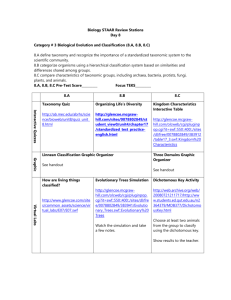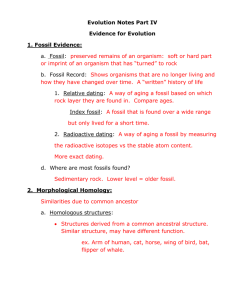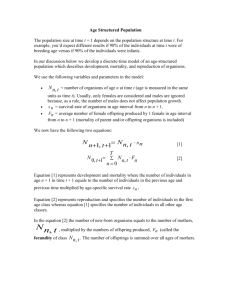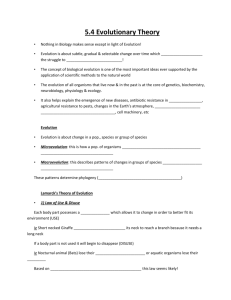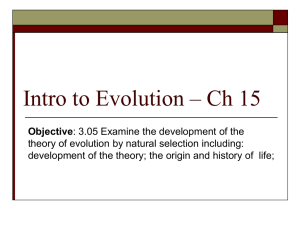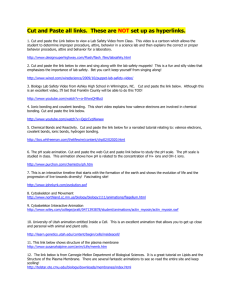12 Day Biology Review File 6 - Ector County Independent School
advertisement
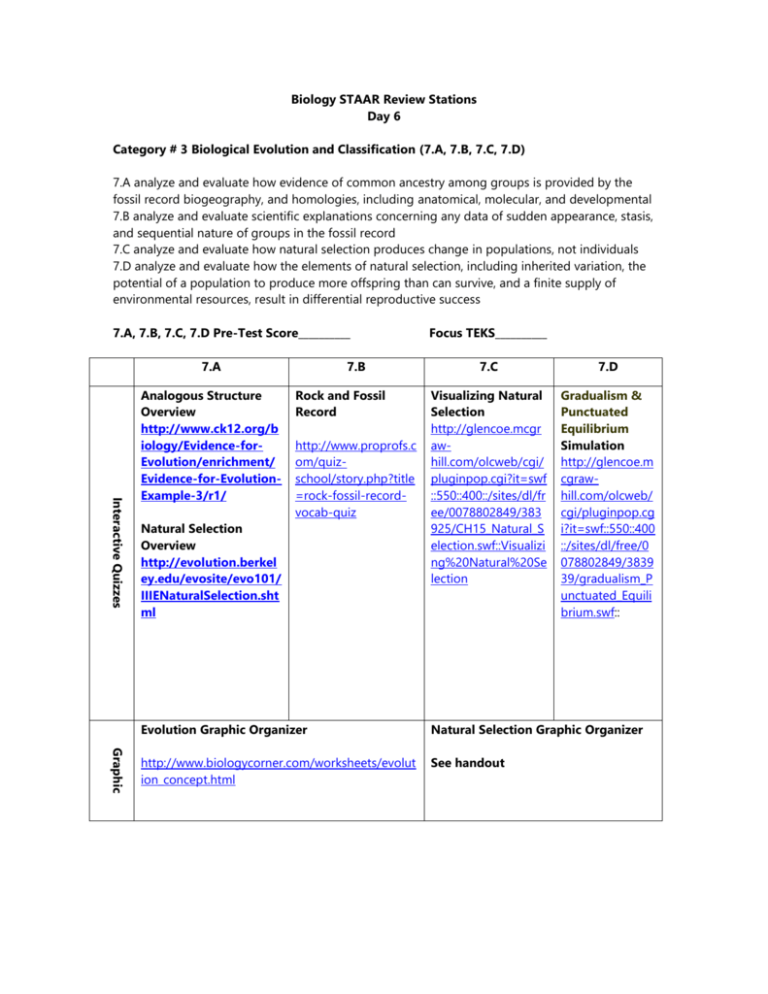
Biology STAAR Review Stations Day 6 Category # 3 Biological Evolution and Classification (7.A, 7.B, 7.C, 7.D) 7.A analyze and evaluate how evidence of common ancestry among groups is provided by the fossil record biogeography, and homologies, including anatomical, molecular, and developmental 7.B analyze and evaluate scientific explanations concerning any data of sudden appearance, stasis, and sequential nature of groups in the fossil record 7.C analyze and evaluate how natural selection produces change in populations, not individuals 7.D analyze and evaluate how the elements of natural selection, including inherited variation, the potential of a population to produce more offspring than can survive, and a finite supply of environmental resources, result in differential reproductive success 7.A, 7.B, 7.C, 7.D Pre-Test Score__________ 7.A Interactive Quizzes Analogous Structure Overview http://www.ck12.org/b iology/Evidence-forEvolution/enrichment/ Evidence-for-EvolutionExample-3/r1/ 7.B Rock and Fossil Record http://www.proprofs.c om/quizschool/story.php?title =rock-fossil-recordvocab-quiz Natural Selection Overview http://evolution.berkel ey.edu/evosite/evo101/ IIIENaturalSelection.sht ml Focus TEKS__________ 7.C 7.D Visualizing Natural Selection http://glencoe.mcgr awhill.com/olcweb/cgi/ pluginpop.cgi?it=swf ::550::400::/sites/dl/fr ee/0078802849/383 925/CH15_Natural_S election.swf::Visualizi ng%20Natural%20Se lection Gradualism & Punctuated Equilibrium Simulation http://glencoe.m cgrawhill.com/olcweb/ cgi/pluginpop.cg i?it=swf::550::400 ::/sites/dl/free/0 078802849/3839 39/gradualism_P unctuated_Equili brium.swf:: Graphic Organizer Evolution Graphic Organizer Natural Selection Graphic Organizer http://www.biologycorner.com/worksheets/evolut ion_concept.html See handout Exploring Evolution Lab http://www2.edc.org/w eblabs/exploringevolut ion/evolution.swf Getting Into Fossil Record Virtual Labs http://www.ucmp.b erkeley.edu/educati on/explorations/tou rs/fossil/9to12/Page 2c.html Basic Principles of Natural Selection Interactive Table http://glencoe.mcgr awhill.com/olcweb/cgi/ pluginpop.cgi?it=swf ::550::400::/sites/dl/fr ee/0078802849/383 912/table15_1.swf::B asic%20Principles%2 0of%20Natural%20S election . How Can Natural Selection Be Modeled? http://www.gle ncoe.com/sites/ common_assets /science/virtual _labs/LS06/LS0 6.html Vocabulary http://quizlet.com/20029412/evolution-flash-cards/ Evidence of Common Ancestry http://www.teachertube.c om/viewVideo.php?video _id=270756 Video Clips Evidence of Evolution Overview http://www.ck12.org/biol ogy/Evidence-forEvolution/enrichment/Evi dence-for-EvolutionOverview/r1/ Homologous Structure Overview http://www.ck12.org/b iology/Evidence-forEvolution/enrichment/ Evidence-for-EvolutionExample-2/r1/ Evolution and the fossil record Archaeopteryx, the missing link The Making of the Fittest: Natural Selection and Adaptation Video Natural Selection and the Owl Butterfly http://www.bbc.co.uk /learningzone/clips/e volution-and-thefossil-recordarchaeopteryx-themissinglink/5523.html http://www.hhmi.org /biointeractive/maki ng-fittest-naturalselection-andadaptation https://www.kh anacademy.org /science/biolog y/evolutionand-naturalselection/v/nat ural-selectionand-the-owlbutterfly Guiding questions: What caused the fur of pocket mice to change from light to dark? Describe a mutation and when it occurs. Describe how this model supports natural selection. Critical Thinking Questions 1. What is the difference between homologous and analogous structures? 2. What are some of the reasons for the differences between organisms? 3. What are some of the results of natural selection? 4. What are the different reasons species are successful today? 5. What are the effects of other evolutionary mechanisms on today’s species? 7.C, 7.D Natural Selection Graphic Organizer Day 6 Review Questions 7.A _____ 1. The image illustrates what evolutionary concept? a. embryological similarities b. variation among species c. vestigial structures d. homologous structures 7.A _____ 2. Identify which of the following is a vestigial structure? a. the human tailbone b. the bill of a finch c. flower color d. fossil cast 7.A Which of layer indicates a period in which large land animals appeared? (layer A is the top and layer F is the bottom) a. b. c. d. layer B layer D layer E layer C 7.A _____4. Structural adaptations help organisms survive in various environments. Which of these is not an example of a structural adaptation? a. The harmless syrphid fly resembles the yellow jacket in coloring and body shape. b. The leaf frog’s coloring and shape make camouflage on the forest floor possible. c. Mole-rats have large teeth and claws which help them dig tunnels and escape predators. d. A lizard finds a shady spot to escape the sun’s heat. 7.B _____5. This illustration compares amino acid sequences in various kinds of organisms. Which statement is correct based on this information? a. b. c. d. humans share no amino acid sequences with monkeys moths have no amino acid sequences humans share more amino acid sequences with pigs than fish turtles and ducks share no amino acid sequences 7.B _____6. The idea that younger rocks lie above older rocks a. relative dating b. superposition c. geologic column d. uniformitarianism 7.B _____7. A detailed series of rock layers that contain all the known fossils and rock formations on Earth: a. relative dating b. superposition c. geologic column d. angular unconformity 7.B _____8. Figuring out whether a rock layer is older or younger than the layers around it. a. absolute dating b. superposition c. relative dating d. half-life 7.C _____ 9. Natural selection generates a. changes in the environment. b. plants and animals to produce more offspring than can survive. c. changes in the frequency of certain alleles in a population d. All of the above 7.C _____10. Within a fish species, variations exist in color, size, and the speed at which individuals can swim. Which variation would be least likely to be passed on to future generations of the species? a. swimming speed which is less than that of predators b. color of markings which aid camouflage c. size which enables hiding among small rocks and in rock crevices d. reproduction by laying extremely large numbers of eggs 7.C _____ 11. A bear produces two offspring. One of the cubs is smaller than normal and has difficulty digesting food. Which statement comparing the two cubs is false? a. The larger bear cub is more likely to survive to reproductive age. b. The smaller bear cub is less likely to pass its genes on to another generation. c. The larger bear is better adapted for survival in its environment. d. Both bear cubs are equally likely to pass their genes on to the next generation. 7.C _____12. Which of these statements about natural selection is true? a. Organisms which survive to reproduce can pass favorable variations on to offspring. b. Natural selection works on individuals, rather than a population of organisms. c. All organisms within a species are genetically identical. d. Offspring can inherit traits of an organism that the organism develops during its life. 7.D _____ 13. The strongest evidence for change over a long period of time comes from: a. DNA b. Fossils c. Embryo studies d. Direct observation of living species 7.C _____ 14. The finches on the Galapagos island were similar in form except for variations of their beaks. Darwin observed that these variations were useful for: a. finding a mate b. defending territory c. building nests d. gathering food 7.D _____15. What’s the difference between genetic drift and change due to natural selection? a. genetic drift does not require the presence of variation b. genetic drift does not involve competition between members of a species c. genetic drift never occurs in nature, while natural selection does d. there is no difference 7.D ______16. Which of the following is/are key features of the theory of evolution? a. offspring with the most favorable traits are the most likely to survive and pass on their genes. b. offspring compete with one another for limited resources. c. organisms in populations are genetically unique. d. all of the abov Day Six Review Questions (7.A, 7.B, 7.C, 7.D) Answer Sheet _____1. _____2. _____3. _____4. 7.A Score__________/4 _____5. _____6. _____7. _____8. 7.B Score __________/4 _____9. _____10. _____11. _____12. 7.C Score__________/4 _____13. _____14. _____15. _____16. 7.D Score__________/4 Day Six Review Questions (7.A, 7.B, 7.C, 7.D) Key __D__1. __A__2. __D__3. __D__4. __C__5. __B__6. __C__7. __C__8. __D__9. __A__10. __A__11. __D__12. __B__13. __D__14. __B__15. __D__16.


